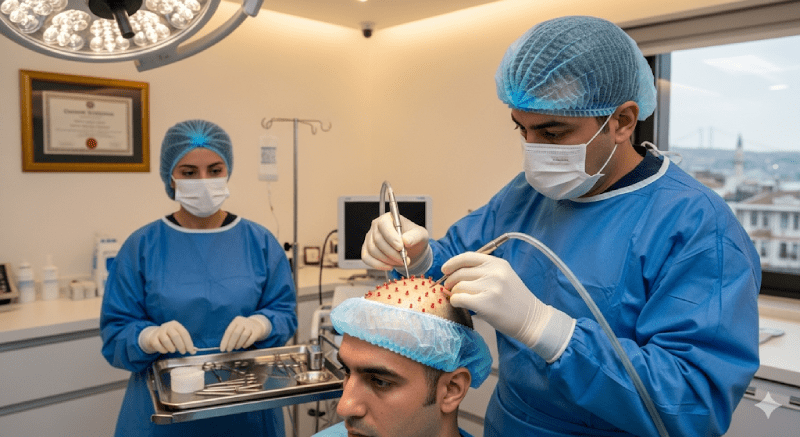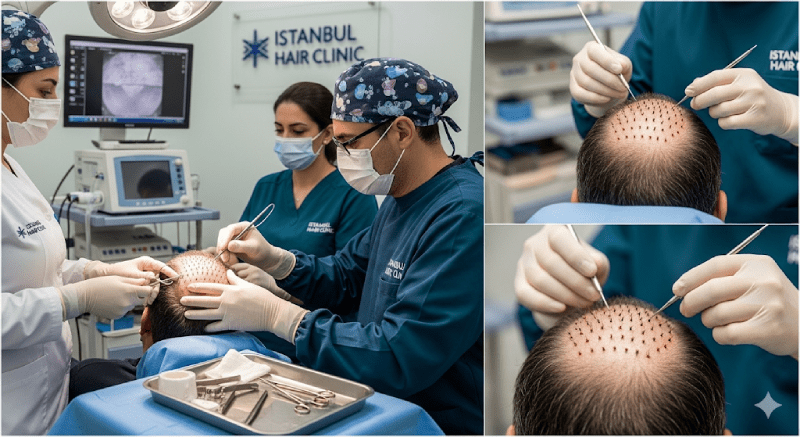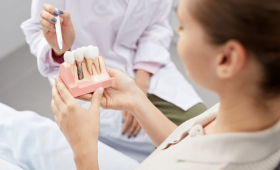The Global Epicenter of Hair Restoration: Why Turkey?
Turkey has emerged as the preeminent global destination for hair transplant procedures, a position solidified by a powerful combination of economic, technological, and strategic factors. The nation’s rise to prominence in the medical tourism sector is not accidental; it is the result of a deliberate cultivation of a patient-centric ecosystem that offers an unparalleled blend of affordability, expertise, and convenience. The overwhelming demand for hair restoration in Turkey is a testament to its ability to meet the needs of international patients seeking high-quality care at a fraction of the cost found in their home countries.
The Economic Engine: Unpacking the Cost Advantage
The primary catalyst for Turkey’s dominance in the hair transplant market is its compelling cost advantage. Data from various sources consistently demonstrate that a procedure in Turkey is significantly more affordable than in Western nations. For instance, the average cost of a hair transplant in Turkey is approximately $2,676, a stark contrast to the average cost of $13,610 in the United States and up to $15,000 in the UK. This translates to a remarkable 50% to 75% savings for patients from the UK and up to 90% for those from the United States.
The cost-effectiveness extends to the micro-level, with the average cost per graft in Turkey ranging from $1 to $3, compared to $4 to $8 in the U.S. and $4 to $6 in the UK. This affordability is rooted in Turkey’s lower operational and labor costs, as well as favorable exchange rates for patients from countries with stronger currencies, such as the Euro, Pound, or Dollar.
This economic dynamic has created a self-reinforcing cycle that fuels the growth and quality of the industry. The low cost attracts a high volume of patients, which in turn provides surgeons and medical teams with an extensive amount of practical experience. Reports indicate that experienced doctors in Turkey perform thousands of procedures annually, giving them a level of expertise in a wide range of cases, from common to complex. A high-volume clinic like Dr. Serkan Aygin Clinic can perform as many as 20 hair transplants daily, with a significant number of patients from the United States and Europe. This constant practice allows Turkish surgeons to refine their skills and stay at the forefront of the industry, further enhancing the country’s reputation for quality and attracting even more patients. The economic appeal is therefore not merely a matter of price; it is the foundational element that has cultivated a deep bench of highly experienced medical professionals.
The All-Inclusive Value Proposition
Beyond the raw cost savings, Turkey’s hair transplant clinics have perfected a comprehensive, all-inclusive package model that addresses the logistical complexities of medical tourism. These packages are a significant departure from the à la carte pricing often found in the UK and other Western countries. The typical all-inclusive offer bundles the surgical procedure with a range of complementary services, including necessary medications, ground transfers to and from the airport and clinic, and comfortable accommodations in four- or five-star hotels.
This strategic business model is a direct response to the unique anxieties faced by international patients. By managing the full patient journey—from arrival to departure—clinics mitigate non-medical risks and simplify the process. Patient testimonials often describe a seamless, hospitality-driven experience, complete with multilingual staff and supportive call centers that provide guidance from the initial consultation through post-operative recovery. This holistic approach transforms what could be a stressful medical journey into a comfortable and well-managed “medical vacation,” thereby enhancing the overall value proposition and justifying the decision to travel abroad for care. The provision of these services builds a strong sense of trust and care, which is a critical part of the patient’s satisfaction and the clinic’s brand reputation.
A Hub of Expertise and Technology
The misconception that affordability implies a compromise on quality is thoroughly debunked by the advanced standards of care found in Turkey. Clinics in major cities like Istanbul and Ankara have a strong reputation for utilizing cutting-edge techniques and advanced surgical equipment. The dominant techniques, Follicular Unit Extraction (FUE) and Direct Hair Implantation (DHI), are considered the latest advancements in the field and are widely available. The use of modern technology, such as the Sapphire FUE method and the Choi Implanter Pen for DHI, ensures minimally invasive procedures that result in natural-looking outcomes with minimal scarring and shorter recovery times.
The industry’s competitiveness has led to continuous innovation. Clinics must constantly invest in the latest technology and techniques to differentiate themselves in a crowded market. This competitive pressure creates a market where even affordable clinics can offer services that are on par with or surpass those in more expensive markets. The presence of internationally trained and board-certified surgeons, along with accreditations from international medical organizations like the Joint Commission International (JCI), provides a further layer of assurance regarding the high standards of care and safety protocols.
The Medical Tourism Ecosystem and Patient Experience
Turkey’s success in medical tourism is not solely a medical achievement; it is also a governmental and cultural one. The Turkish government, through the Ministry of Health, has actively promoted medical tourism, leading to a significant boom in the sector. This initiative has leveraged Turkey’s existing robust tourism infrastructure, which includes a well-developed public transport network and a wide array of cultural and historical attractions, to provide a comprehensive experience for patients.
The cultural appeal and warm hospitality for which Turkey is renowned are also integral to the patient experience. Patient testimonials frequently highlight the welcoming attitude of the staff and the ease of navigating the city, which makes the journey more enjoyable and less intimidating. This symbiosis of medical and non-medical elements means that patients are not simply purchasing a medical procedure; they are investing in a comprehensive solution that includes a positive, supportive, and memorable travel experience. This holistic approach significantly contributes to patient satisfaction and reinforces Turkey’s position as a leader in global hair restoration.
Table 1: International Hair Transplant Cost & Value Comparison
| Location | FUE Procedure Cost (USD) | Cost Per Graft (USD) | All-Inclusive Packages? |
| Turkey | $1,500 – $6,000 | $1.00 – $3.00 | Yes, typically |
| United States | $13,610 (avg) | $4.00 – $8.00 | No, typically not included |
| United Kingdom | $5,800 – $12,500 | $4.00 – $6.00 | No, typically not included |
| Poland | $4,000 – $6,000 | $2.50 – $3.50 | Yes, some clinics offer |
| Lithuania | $3,000 – $5,000 | $2.50 – $5.00 | Yes, some clinics offer |
| Hungary | $3,700 – $5,500 | $1.50 – $2.50 | Yes, some clinics offer |
The Science and Art of Hair Transplants: A Deep Dive into Techniques
Hair transplantation has evolved from the conspicuous “hair plugs” of the past into a sophisticated medical and aesthetic practice. This evolution is largely thanks to the refinement of modern techniques that prioritize natural-looking results, minimal invasiveness, and a high degree of precision. In Turkey, clinics have embraced these advanced methods, with two techniques standing out as the industry’s gold standards: Follicular Unit Extraction (FUE) and Direct Hair Implantation (DHI). Understanding the differences between these methods is crucial for any prospective patient.
Follicular Unit Extraction (FUE): The Gold Standard
Follicular Unit Extraction, or FUE, is the most common hair transplant technique used in Turkey due to its effectiveness and patient-friendly outcomes. The procedure is minimally invasive and involves the individual extraction of follicular units—natural groupings of 1-4 hairs—from a donor area, typically the back and sides of the head. This process is performed using a specialized micro-surgery tool, which makes tiny, circular excisions that are typically less than 1mm in diameter.
A key advantage of FUE is that it avoids the need for a linear incision or a “strip” of tissue to be removed, a characteristic of the older FUT (Follicular Unit Transplant) method. The result is no visible linear scarring, only tiny dot scars that fade quickly and are easily concealed by surrounding hair. Once the grafts are harvested, they are preserved in a nourishing liquid solution to maximize their viability before being transplanted into the recipient area. The final step, implantation, involves creating small incisions in the balding area and carefully placing the follicles at the proper density, angle, and direction to ensure a natural-looking hairline and appearance. This method is highly reliable, provides a permanent solution to hair loss, and is associated with a high success rate.
Direct Hair Implantation (DHI): Precision and Density
Direct Hair Implantation, or DHI, represents a further advancement of the FUE method, often considered the most recently developed and effective technique for achieving a natural-looking hair transplant. The core differentiator of DHI is its use of a pen-shaped medical instrument, known as a “Choi Implanter Pen”. This sophisticated tool allows the surgeon to directly implant the extracted hair follicles into the scalp, bypassing the need to pre-create micro-channels for implantation. This one-step implantation process reduces the time the follicles spend outside the body, which can optimize their viability and survival rate.
The DHI method offers several unique advantages. The precise application enabled by the implanter pen allows for a higher density of transplanted hair and full control over the angle and direction of hair growth, leading to an exceptionally natural-looking result. This precision also minimizes bleeding, scarring, and trauma to the scalp, which often leads to a shorter recovery time compared to FUE. While DHI is more suitable for smaller transplantation areas and can be more expensive than FUE due to the required expertise, it is particularly effective for procedures that require high-density results, such as beard or eyebrow restoration, or for patients who wish to avoid shaving their entire head. The choice between FUE and DHI is not a matter of one being inherently superior, but rather a medical decision based on the size of the treatment area, the patient’s specific goals, and the surgeon’s recommendation.

The Nuance of Grafting and Hairline Design
Regardless of the technique used, the success of a hair transplant is a function of both the surgeon’s technical skill and their artistic vision. The procedure is not merely a technical exercise in moving hair from one place to another; it is a meticulous process of reconstruction and aesthetic design. A key component is the strategic planning of the hairline and the careful placement of each individual graft.
Leading clinics in Turkey, such as Hermest Hair Clinic, emphasize a personalized hairline design that is customized for each patient based on facial muscle analysis, facial proportions, and individual hair characteristics. This artistry is what prevents an unnatural, “pluggy” appearance and ensures the final result looks as if the hair has been there all along. The viability of the grafts is also paramount, with some clinics reporting a graft survival rate of up to 99%. By combining a high graft survival rate with strategic density planning, surgeons can achieve high-density, natural-looking hair even with a limited number of grafts. The combination of technical precision and aesthetic consideration is what elevates a hair transplant from a medical procedure to an art form.
Table 2: FUE vs. DHI Technique Comparison
| Criteria | Follicular Unit Extraction (FUE) | Direct Hair Implantation (DHI) |
| Procedure Overview | Grafts extracted one-by-one; incisions pre-made with a blade; grafts manually placed into incisions. | Grafts extracted one-by-one; grafts loaded into a “Choi Pen” and simultaneously implanted and the channel is created; no pre-made incisions. |
| Key Advantages | Widely used, effective for large areas, minimally invasive, no linear scarring. | Higher precision, greater density, less bleeding, faster recovery, suitable for “no-shave” procedures. |
| Best For | Patients needing a large number of grafts (e.g., covering a large balding area). | Patients needing high density in smaller areas (e.g., hairline, beard, eyebrows) or those prioritizing minimal scalp trauma. |
| Typical Cost | More affordable than DHI. | Can be more expensive due to specialized tools and expertise required. |
Navigating the Journey: A Comprehensive Patient’s Timeline
A successful hair transplant journey is a comprehensive process that extends far beyond the day of the surgery. It begins with thorough pre-procedure preparation, culminates in the surgical experience, and continues with a phased post-operative recovery. A clear understanding of this timeline is crucial for managing expectations and ensuring a satisfactory outcome.
Pre-Procedure Protocols: From Virtual Consult to Visa
The initial phase of the journey involves meticulous planning and communication. The process typically begins with a virtual consultation, often conducted via a video call or by exchanging photos with a clinic’s medical team. This remote assessment is a critical step in which a surgeon or medical consultant evaluates a patient’s hair loss, determines their candidacy for a transplant, and proposes a personalized treatment plan. A trustworthy clinic will use this opportunity to provide a thorough, unpressured assessment, ensuring the patient fully understands their options and has realistic expectations. A clinic that is overly eager to book a procedure without a proper medical assessment is a significant red flag.
For international patients, a crucial pre-travel step is securing a medical visa, unless they are from a visa-exempt country. This process requires several key documents, including a formal invitation letter from the Turkish hospital, proof of financial means (at least $50 per day to cover expenses), a passport with a minimum of six months validity, and proof of accommodation. The visa application can be completed online through the official Turkish e-visa website or in person at an embassy, a process that should be initiated at least a month before the planned trip to account for potential processing delays.
The On-Site Experience: Arrival and the Day of Surgery
Upon arrival in Turkey, the patient’s journey is made seamless by the all-inclusive packages offered by many clinics. These packages typically include efficient airport transfers and luxurious hotel accommodations, which are designed to put the patient at ease from the moment they land. Testimonials describe a welcoming and supportive environment where multilingual staff are on hand to facilitate a smooth transition. This full-service model, from the airport to the hotel, transforms the experience from a potentially daunting medical trip into a comfortable, well-managed event.
The day of the surgery itself is a major milestone. The procedure, which can last up to 8 hours, is performed under local anesthetic. Patients often report feeling little more than a mild pressure, comparing the experience to a head massage, and describe the process as largely pain-free. Some reputable clinics take additional safety precautions, performing pre-operative evaluations with specialists like a cardiologist or dermatologist to ensure the patient is in good health for the procedure. This meticulous approach to on-site care and patient comfort is a testament to the industry’s commitment to providing a superior experience.
Post-Operative Care: A Phased Recovery Timeline
The recovery from a hair transplant is a multi-stage process that requires patience and diligent aftercare. The timeline for recovery and the emergence of final results can be broken down into distinct phases.
- Days 1–3: The Immediate Phase: This is a critical period for healing. Patients may experience slight redness, swelling, and the formation of tiny scabs where the grafts were implanted. It is essential to avoid touching or washing the area, sleep with the head elevated to manage swelling, and wear a protective cap when outdoors.
- Days 4–7: Gentle Cleansing and Monitoring: Around day four, with a surgeon’s guidance, patients can begin gently washing their scalp using a soft shampoo and a patting motion. It is crucial to avoid rubbing, scratching, or towel drying the area. Mild itching may occur as the scalp heals, but patients must not pick at the scabs, as they protect the newly implanted grafts.
- Week 2: The Shedding Phase: Many patients experience a temporary shedding of the transplanted hairs during the second week. This “shock loss” is a completely normal and expected part of the hair growth cycle and should not be a cause for concern. It is a sign that the hair follicles have entered a resting phase before new, permanent hair begins to grow.
- Weeks 3–4: Transition and Skin Recovery: By this time, the scalp’s appearance begins to normalize as redness and flaking fade. The transplanted grafts are fully secured, and patients can resume light physical activity.
- Months 2–3: New Hair Begins to Emerge: Between weeks six and twelve, the first signs of new, fine hair growth will begin to appear. This growth is gradual, and the texture may initially differ from existing hair.
- Months 4–6: Noticeable Volume Development: This stage brings a significant improvement in hair density and coverage. The new growth continues to increase, and the hair begins to take on a thicker texture and improved coverage in the treated areas.
- Months 10–12: Final Outcome Achieved: The full, final results of the hair transplant are typically visible by one year. At this point, the new hair has fully matured, blending naturally with the patient’s existing hair and achieving the desired thickness and density.
A detailed recovery timeline like this is a vital tool for clinics to manage patient expectations and prevent anxiety, especially during the temporary and often alarming shedding phase. A reputable clinic will provide this information proactively, demonstrating its commitment to patient education and support beyond the surgical procedure.
Table 3: Phased Post-Operative Recovery Timeline
| Phase | Expected Timeline | Key Milestones & Care Instructions |
| Immediate Post-Op | Day 1–3 | Slight redness, swelling, and scabs. Avoid touching or washing the area. Wear a protective cap outdoors. Sleep with head elevated. |
| Early Healing | Day 4–7 | Begin gentle cleansing with soft shampoo and a patting motion. Avoid rubbing or scratching. Use saline spray. Do not pick scabs. |
| Shedding Phase | Week 2 | Transplanted hairs begin to shed. This is normal “shock loss.” Continue gentle care routines. |
| Skin Recovery | Weeks 3–4 | Redness and flaking fade. Grafts are fully secured. Can resume light physical activity. |
| Early Growth | Months 2–3 | First signs of new, fine hair emerge. Maintain a balanced diet and stay hydrated to support regrowth. |
| Noticeable Volume | Months 4–6 | Visible changes in hair density and coverage. Thicker texture and improved coverage. |
| Final Outcome | Months 10–12 | Full, final results are visible. Hair blends naturally with existing hair. Styling becomes effortless. |
The Critical Component: Due Diligence, Risks, and Red Flags
While Turkey offers a compelling value proposition, a potential patient must exercise extreme caution to avoid the pitfalls of the industry’s unregulated side. The medical tourism sector in Turkey, like any other, has a spectrum of providers, from world-class, accredited clinics to dangerous, unlicensed operations. The user’s ultimate satisfaction depends heavily on their ability to perform thorough due diligence and identify key red flags.
The Dangers of the Black Market and “Hair Mills”
The very forces that have fueled the success of reputable clinics—high volume and efficiency—have also given rise to a dangerous black market of so-called “hair mills.” These are clinics that prioritize profit over patient safety, often performing an excessive number of procedures in a single day at the expense of individualized care. A key red flag is a clinic that promises “unlimited grafts” or a massive “mega-session” of up to 5000 grafts in one sitting. While this may sound appealing for efficiency and cost savings, such aggressive sessions can lead to serious risks, including excessive blood loss, poor blood supply to the grafts, and an irreversible loss of hair due to poor graft survival.
A fundamental issue with these operations is the lack of qualified personnel. Many “hair mills” advertise the expertise of a renowned surgeon, but the actual procedure is often performed by unlicensed technicians with no medical training. These individuals lack the necessary skill and understanding of anatomy to perform a complex procedure safely. The result can be disastrous, leading to permanent scarring, overharvesting of the donor area, or unnatural-looking results that require costly and difficult corrective surgery.

Identifying and Mitigating Risks
In addition to the risks posed by the black market, there are inherent medical and logistical risks associated with any surgical procedure, especially one performed abroad.
- Medical and Surgical Complications: While most side effects, such as swelling, pain, itching, and temporary “shock loss,” are minor and resolve on their own with proper aftercare, more serious complications can occur. These include infection, which can occur if proper hygiene standards are not followed, or in rare cases, chronic pain or keloid scarring. The risk of these complications is significantly higher at unaccredited facilities that may lack the necessary equipment or sterile environment.
- Logistical and Legal Risks: A patient traveling outside their home country for a procedure faces unique logistical challenges. In the event of complications after returning home, it can be extremely difficult to find a local surgeon willing to take over the patient’s care. Furthermore, legal recourse is limited, as the patient’s home country’s laws do not apply to a procedure performed abroad. This lack of legal protection places the onus of due diligence entirely on the patient.
The “one-and-done” approach often marketed by aggressive clinics can be particularly deceptive. A successful hair transplant does not stop progressive hair loss in non-transplanted areas. An ethical surgeon will set realistic expectations and explain that a patient may require follow-up procedures or ongoing treatments in the future to maintain ideal results.
The Ultimate Vetting Checklist: How to Choose a Reputable Clinic
The most effective way to mitigate these risks is through a rigorous and methodical vetting process. A prospective patient should always choose the surgeon, not just the brand name of the clinic. The following checklist provides a framework for selecting a reputable and trustworthy provider.
- Surgeon Credentials and Transparency: It is imperative to verify that the surgeon is a qualified doctor with proper board certification. Ask for the surgeon’s name and experience, and confirm that they, and not an unlicensed technician, will be performing the entire procedure. Membership in a recognized international society, such as the International Society of Hair Restoration Surgery (ISHRS), is a strong indicator of a surgeon’s commitment to high standards.
- Clinic Accreditations and Certifications: Look for clinics that are accredited by international organizations like the Joint Commission International (JCI), which certifies healthcare facilities for quality and safety. The Turkish Society of Plastic, Reconstructive and Aesthetic Surgeons (TSPRAS) is the main legally recognized body in the country, and their website lists member plastic surgeons.
- Patient Reviews and Case Studies: Conduct thorough research by reading patient reviews on independent websites like Google, RealSelf, and Yelp. A reputable clinic should have a comprehensive gallery of high-quality before-and-after photos, which can provide valuable insights into the quality of their work and their ability to create natural-looking results.
- Transparent Pricing and Consultation Process: A trustworthy clinic will provide transparent, detailed pricing with no hidden costs. Be wary of clinics that offer suspiciously cheap deals or use high-pressure sales tactics to rush a booking. A proper consultation should include a thorough medical assessment of your candidacy and a personalized treatment plan. A clinic that is eager to book a procedure without a proper medical evaluation is a significant red flag.
Table 4: The Ultimate Vetting Checklist for Clinic Selection
| Vetting Criteria | What to Look For | Why It Matters |
| Surgeon Credentials | A board-certified surgeon with membership in international societies like the ISHRS or ABHRS. | Ensures a qualified doctor, not an unlicensed technician, is performing the surgery. |
| Clinic Accreditations | JCI accreditation, TSPRAS membership, or other verified certifications. | Indicates adherence to strict international standards for quality and safety. |
| Transparency & Ethics | Detailed, transparent pricing with no hidden costs; a personalized treatment plan after a proper medical assessment. | Safeguards against hidden fees, rushed procedures, and unrealistic promises. |
| Patient Vetting | The clinic carefully evaluates if a patient is a suitable candidate. | A reputable clinic will not perform a procedure if it is not medically appropriate, avoiding overharvesting and poor results. |
| Reputation & Results | A comprehensive gallery of before-and-after photos; positive reviews on independent patient review websites. | Provides objective evidence of the surgeon’s skill and the quality of their results. |
A Realistic Look at Long-Term Results
One of the most important elements of a successful hair transplant is managing expectations for long-term outcomes. The promise of a full head of hair can be enticing, but an ethical clinic will be transparent about the reality of hair transplantation. The procedure provides a permanent solution for the transplanted hair follicles because they are harvested from areas of the scalp that are typically immune to male pattern baldness. However, a hair transplant does not stop the progression of hair loss in other, non-transplanted areas.
An experienced surgeon will discuss the patient’s individual case, their ongoing hair loss pattern, and the potential need for future procedures to maintain a natural-looking appearance over time. A patient’s long-term satisfaction is directly tied to the realism of their initial expectations. By prioritizing a clinic that is transparent about potential long-term needs, a patient can ensure their “dream” hair transplant is a lasting and successful investment.
Synthesis and Actionable Recommendations
Turkey’s position as the global leader in hair transplants is a multifaceted phenomenon driven by an undeniable economic advantage, a sophisticated medical ecosystem, and a patient-centric, all-inclusive business model. The confluence of these factors has created a market where high-quality, advanced procedures are not only accessible but also complemented by a seamless, hospitality-driven experience. The significant cost savings, combined with the deep pool of experienced surgeons and the adoption of cutting-edge techniques like FUE and DHI, make a compelling case for Turkey as a destination for hair restoration.
However, the industry’s rapid growth has also attracted opportunistic providers who operate with little to no regard for patient safety. The risks of dealing with “hair mills” and unlicensed practitioners are real and can lead to irreversible and costly complications. The journey to a “dream” hair transplant is therefore not a simple transaction; it is an investment that requires a partnership between an informed patient and a reputable, ethical medical team.
A Balanced Analysis of Benefits vs. Risks
The benefits of a hair transplant in Turkey are substantial:
- Affordability: Procedures are a fraction of the cost found in Western countries, with savings of 50-90%.
- Expertise: The high volume of procedures has cultivated a deep pool of experienced, and in many cases, internationally trained surgeons.
- Convenience: All-inclusive packages simplify travel and logistics, providing a stress-free experience from arrival to departure.
The potential risks, while significant, are largely avoidable through due diligence:
- Unqualified Providers: The risk of procedures being performed by unlicensed technicians in unaccredited facilities is a major concern.
- Limited Recourse: Patients have little to no legal protection or access to follow-up care if complications arise after returning home.
- Unrealistic Promises: Aggressive marketing tactics can lead to unrealistic expectations and pressure patients into risky “mega-sessions” or inappropriate procedures.
A Final Pre-Travel Checklist
To navigate the process safely and effectively, a prospective patient should follow these final steps before traveling:
- Confirm Surgeon and Clinic Credentials: Use the vetting checklist to verify the surgeon’s board certification and the clinic’s accreditations.
- Secure Visa and Documents: Initiate the medical visa application process at least one month in advance. Ensure all required documents, including the hospital invitation letter and proof of financial means, are in order.
- Finalize Package Details: Confirm that the all-inclusive package includes all transfers, accommodation, medications, and aftercare services to avoid hidden costs.
- Plan for Aftercare: Be prepared to follow all post-operative instructions diligently, including avoiding strenuous activity and certain foods that can thin the blood. Pack a protective cap and any prescribed medications as instructed.
The Path to Your “Dream” Hair Transplant: Final Considerations
A “dream” hair transplant is one that not only produces a natural, aesthetically pleasing result but also ensures a safe and comfortable experience. This outcome is not a matter of luck; it is a direct consequence of a patient’s commitment to thorough research and a careful selection of their medical team. By transforming from a passive consumer into an empowered decision-maker, a patient can confidently embark on their journey, assured that they have taken every possible step to ensure a safe and successful outcome. The Turkish medical tourism industry, at its best, represents a powerful convergence of medical excellence and value, offering a real and attainable path to hair restoration for a global audience.
Hair Restoration with Cure Holiday!
Hair loss can be a frustrating experience for both men and women, often negatively impacting self-confidence. Fortunately, with advancements in technology, a lasting solution to this problem is now easily achievable through hair transplantation.
At Cure Holiday, we provide the highest quality service with our team of specialized and experienced doctors and modern medical facilities in the field of hair transplantation. Our goal is not only to help you regain your hair but also to make this process comfortable and safe for you.
Why Choose Cure Holiday?
- Expert and Experienced Staff: We work with surgeons who have many years of experience in hair transplantation.
- Latest Technology Applications: We use the most current techniques such as FUE (Follicular Unit Extraction) and DHI (Direct Hair Implantation) to achieve natural and successful results.
- Personalized Treatment Plan: Every patient’s needs are different. Therefore, we prepare a personalized treatment plan that is tailored to your expectations.
- Comfortable and Safe Environment: We consider every detail to ensure your comfort during your treatment. Your hygiene and safety are our top priorities.
- Affordable Prices: We aim to offer high-quality service at prices that fit your budget.
Hair transplantation is not just a treatment; it’s an investment in yourself. With the expertise and assurance of Cure Holiday, you can regain the thick, healthy hair you’ve always dreamed of and make a new start.
Contact us for more information, to benefit from our free consultation, and to take the first step on your hair transplantation journey.



